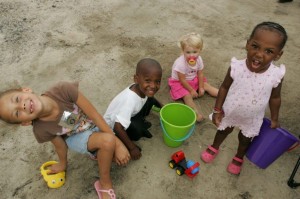 Celebrating Get Outdoors Day is as easy as going to the playground with your child for some fun, learning, and kindergarten readiness. Surprising as it sounds, children’s achievement in school is influenced by their social confidence. Because playgrounds often have quite a few children all playing and having fun, it’s a great place to support your child to develop some early social skills.
Celebrating Get Outdoors Day is as easy as going to the playground with your child for some fun, learning, and kindergarten readiness. Surprising as it sounds, children’s achievement in school is influenced by their social confidence. Because playgrounds often have quite a few children all playing and having fun, it’s a great place to support your child to develop some early social skills.
Yesterday’s blog post (see Playground Fun, Learning & Kindergarten Readiness #4) talked about ways to help children take turns, wait, and share; today the topic is helping kids to make friends.
Children begin to develop more social play about the age of three. On a playground, there may be some children that your child already knows and some that are new. It will be easier for your child to smile and say hello to people that are familiar but you can prompt your child as you get closer to the playground. You might say something like “There might be some people that you do not know at the playground. Did you know that even if we do not know them, we can smile at them? Here is my smile. Does it look ready to you? Okay, show me yours and I will see if it’s ready.” You have not told your child to smile at people, but the message is there. A smile is the beginning of a connection.
If some children are doing an activity that your child might like, you can stand close enough to them so that the kids can hear you and mention something like “Oh, that looks like fun. I bet you could _____.” Suggest something that your child can do to fit in, such as hold something or build with them. Usually, one of the other kids who has heard you will agree and add a response, such as “Ya, you can use that space.” Once the kids are playing together or even just beside each other doing their own thing, you can be less involved. Sometimes, asking “Can I play?” is too risky for kids so it is easier to notice what they are doing and to make a simple statement.
Another strategy is to again notice what someone else is doing. For instance, if there is a little girl who jumped over log, you may say to your child, but so the little girl can hear too, “That little girl jumped over the log. It looked like fun. Would you like to ask her to do it again and then you could show her something?” Kids pick up on hints and the little girl will likely jump over the log and then talk to your child. Or, “That little boy climbed up the ropes. Would you like to ask him to do it again and then you can try?” Often, that’s all it will take.
When children are ready, they will use these strategies on their own. They do not know them and need us to model how it works. Having lots of examples, experiences, and opportunities will help children feel comfortable and confident about making friends. Will it be Get Outside Day for your child today?
